7 Best Budget Routers in 2023
Hello, and welcome to our roundup of the best budget routers in the world right now.
Throughout the past few weeks, we’ve tested countless routers. So it’s about time we pick the best.
All-in-all, we feel that the best router for the budget-conscious of us is the TP-Link Archer AX10. Because it’s fantastically well-priced for what you get.
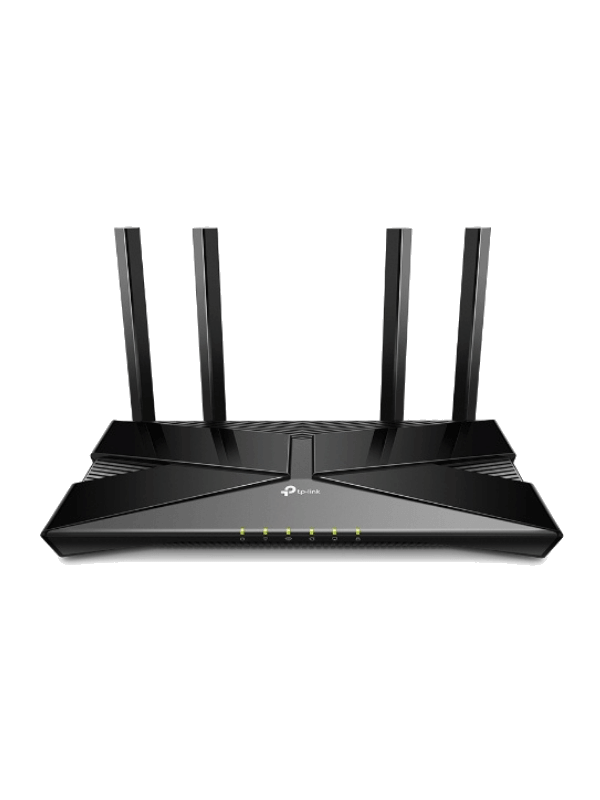
Mục Lục
TP-Link Archer AX10 AX1500
Best Overall
- Type: Wi-Fi router
- Tested max speed: 651.97 Mbps
- Recommended for: 600 Mbps or below
- Works with: 15-20 smart devices
- Wireless standard: Wi-Fi 6
- Warranty: 2 years
Let’s be clear, though. There might be a better router out there that suits your personal circumstances. That’s why we’ve picked a total of seven of the finest.
You’re bound to find the right router for you, so stick with us as we reveal them!
Top 7 Budget Routers
Here’s a look at our top picks overall.
7 Best Budget Routers
Here are short reviews of the best budget routers.

- Type: Wi-Fi router
- Tested max speed: 651.97 Mbps
- Recommended for: 600 Mbps or below
- Works with: 15-20 smart devices
- Wireless standard: Wi-Fi 6
- Warranty: 2 years
Pros
- Strong speed for the price
- Reasonable range
- Smart features
Cons
- No USB ports
Anyone with a download speed of up to 600 Mbps or so should seriously consider the TP-Link Archer AX10. We feel that it’s the best budget router overall.
It’s one of the most affordable Wi-Fi 6 routers going but that isn’t the only great thing about it. The AX10 carries a lot of features and packs an unexpected punch when it comes to performance.
In fact, the AX10 outperforms a lot of much more expensive routers. We tested it with a Wi-Fi 6 device on the 5 GHz band from 5ft away and managed a speed of 651.97 Mbps. That’s more than enough speed for pretty much anyone.
Even when you get a lot further away from the router, it keeps up with the competition. From 50ft away, it managed 91.55 Mbps. That being said, the range is a tiny bit short at 80-90ft so this may not be the perfect budget router for those with large homes.
There’s also no way to boost the range seamlessly (e.g. Mesh). So if you find that the AX10 comes up short in your home range-wise, you’ll need to pick up a Wi-Fi extender. Something to consider.
We could only really find one other slight downside about this router, and that’s that there are no USB ports. This means you won’t be able to plug in any external hardware. But that’s not really going to be much of a problem for most people.
This is more than made up for by the cool features of the AX10. It comes with a neat app for setup and to control the likes of Quality of Service (QoS) and parental controls. Plus, there’s smart Wi-Fi technology included: MU-MIMO, beamforming and OFDMA.
These technologies improve the performance of your router in a few ways. Using different techniques, they all work together to improve the time it takes to connect to your devices and the overall speed of the network.
And all those features for a fantastic price. You really won’t find that level of performance and features for the price anywhere else. This is one heck of a budget router!
Just be aware that you will need to buy a modem if you have cable internet. This router isn’t a modem/router combo, as is the case for every router in our picks today. If you need to grab a modem, we’ve put together some of the best ones of those as well.
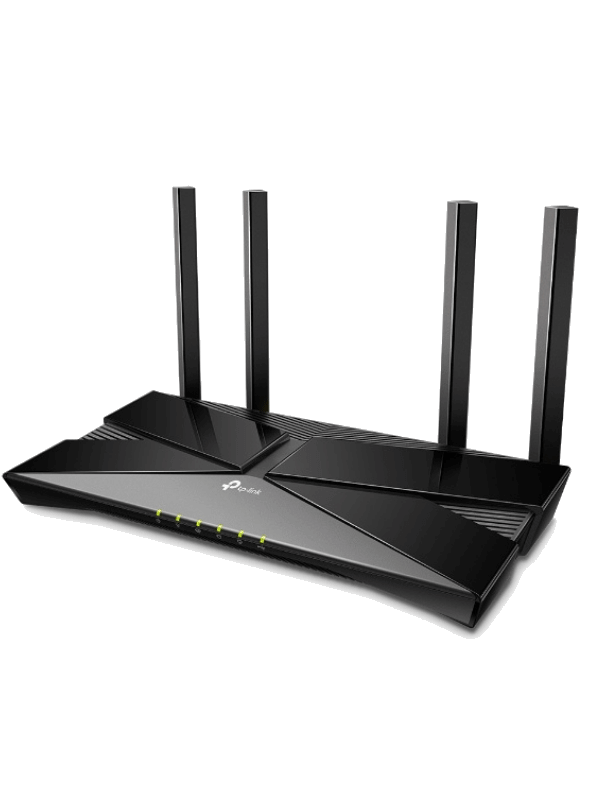
- Type: Wi-Fi router
- Tested max speed: 690.52 Mbps
- Recommended for: 600 Mbps or below
- Works with: 20-30 smart devices
- Wireless standard: Wi-Fi 6
- Warranty: 2 years
Pros
- Great range
- Lightning fast
- Great features (QoS, Parental Controls, etc)
Cons
- Missing OneMesh
- Costs more
If you like the sound of the AX10 but want a little bit more performance and better range, consider upgrading to its older brother, the TP-Link Archer AX50. This is a fantastic router for those with slightly faster internet plans.
That being said, don’t get too hung up on the performance differences between the AX50 and the AX10 as alone, they’re not worth the upgrade. The max speed we tested here was 690.52 Mbps. That’s just 40 Mbps more than the AX10. But it’s plenty fast enough for anyone, really.
The only time it’s really worth paying the extra cash for this router is if you have a large home. It does have a better range. We found that the range maxed out here at 90-100ft. The 10ft more than the AX10 is more than it seems. It’s a whole extra room of the house.
It’s worth being clear at this point that the jump in price from the AX10 to the AX50 isn’t so severe. So it’s definitely worth considering if you want that extra bit of range.
You’ll get the same features as the AX10 (Tether app, Wi-Fi technologies etc.) and a little more. The AX50 comes with better security, another reason it justifies the extra price.
That security comes in the form of something called Homecare. It covers a few things, but the main part to focus on here is the antivirus protection. It’s free for life, which is rare for router manufactures. And it does a great job of protecting your network from threats.
The security goes one step better as just like with the AX10, you’ll have a two year warranty to protect you.
The drawbacks? We’d perhaps like it to have the TP-Link Mesh feature, named OneMesh, for this price. But you’ll have to upgrade to the AX55 to get that. However, at this point, we’re basically out of budget router territory.
Nonetheless, the AX50 is a cracking router for the price. You’ll just need to weigh up whether it’s worth buying it over the AX10 based on the size of your home and your internet plan.

- Type: Wi-Fi Mesh router
- Tested max speed: 317.27 Mbps
- Recommended for: 300 Mbps or below (and for those with big homes!)
- Works with: 15-20 smart devices
- Wireless standard: Wi-Fi 5
- Warranty: 2 years
Pros
- Reasonable price
- Excellent range
- Great features (QoS, Parental Controls, etc)
Cons
- Not the fastest kit
We’re going up through the house sizes again now as we look at the first Mesh system on our list: the TP-Link Deco S4. This is a fantastic idea for those with large homes (or workplaces) but not ultrafast internet plans.
The max speed of this router that we managed, 317.27 Mbps, is still very good for a low-priced Mesh system. Realistically, a whole family or medium-sized workplace will still be happy with this kind of speed.
But where the Deco S4 really makes a name for itself is its range. The beauty of Mesh is that you can connect multiple satellites to the network that connect to your device seamlessly. No need to switch to a new network whenever you go to another part of the house.
Deco S4 allows you to connect up to 10 satellites to the network. Each of those satellites has a range of 50ft so we can consider the theoretical range of a Deco network to be 500ft. Huge!
Of course, connecting 10 satellites would put you out of ‘budget’ territory but you can pick up the S4 kit (one router and two satellites) for a very good price. It definitely offers very strong value for money.
In terms of extra features, you get the standard TP-Link two years warranty plus decent QoS, Alexa compatibility, and more.
It’s worth noting that the actual satellites aren’t going to be quite as quick as the original router so you’re going to lose a little speed the further out you get. But other than that, we don’t really see any flaws with this Mesh network at all.
If you’re looking for a Mesh network and don’t want to spend a fortune, this could well be the one for you.
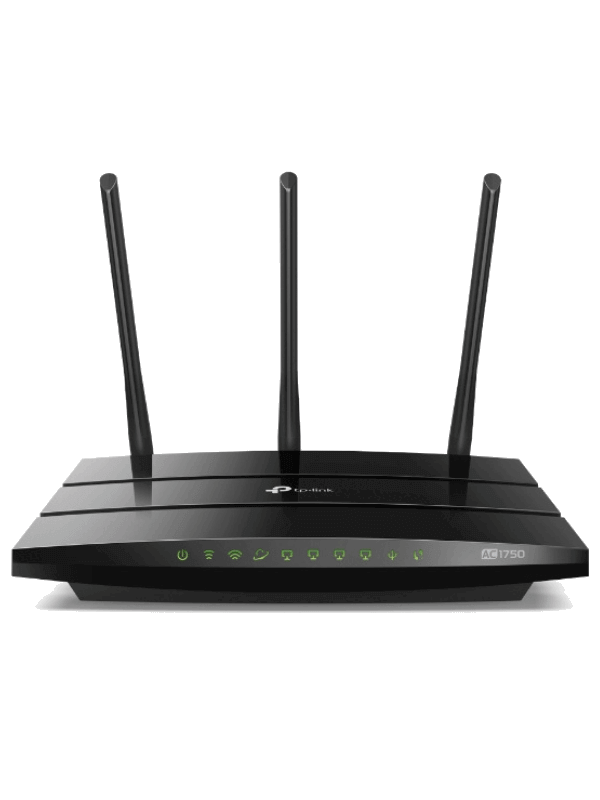
- Type: Wi-Fi router
- Tested max speed: 438.39 Mbps
- Recommended for: 400 Mbps or below
- Works with: around 10 smart devices
- Wireless standard: Wi-Fi 5
- Warranty: 2 years
Pros
- Fast for price
- Affordable
Cons
- Lacks features
- Easily scratched
Those looking for a seriously low budget router but still a reasonable performance will surely be interested in the TP-Link Archer A7. You’re just not going to want to buy it if your internet plan is more than 400 Mbps.
The download speed is still pretty exceptional considering how affordable this router is. We found that it managed a top speed of 438.39 Mbps. Plenty of speed for most people!
It does okay for range, too. The same as the AX10, we found that it could achieve 80-90ft. So if you have a medium-sized home, this router should do the trick for you. Once again, you’ll need a standard Wi-Fi extender if you want to get a wider range than this.
There are some features, but not many. While it does have parental controls, the QoS is rather limited. Plus, there’s no OFDMA, MU-MIMO or beamforming, all of which will shorten the time it takes to connect to your devices and improve the overall speed of the network.
Another small flaw we noticed about the A7 is that it can become quite easily scratched. So you’ll need to take good care of it to avoid damage!
You do still get to use the TP-Link Tether app, though. And we’re big fans of that as you might have noticed already. Plus, there are two years of warranty on offer as is the case with most TP-Link devices.
These are minor things though. For a router so cheap, the A7 ticks a lot of boxes. This could certainly be the prime choice for many people out there.
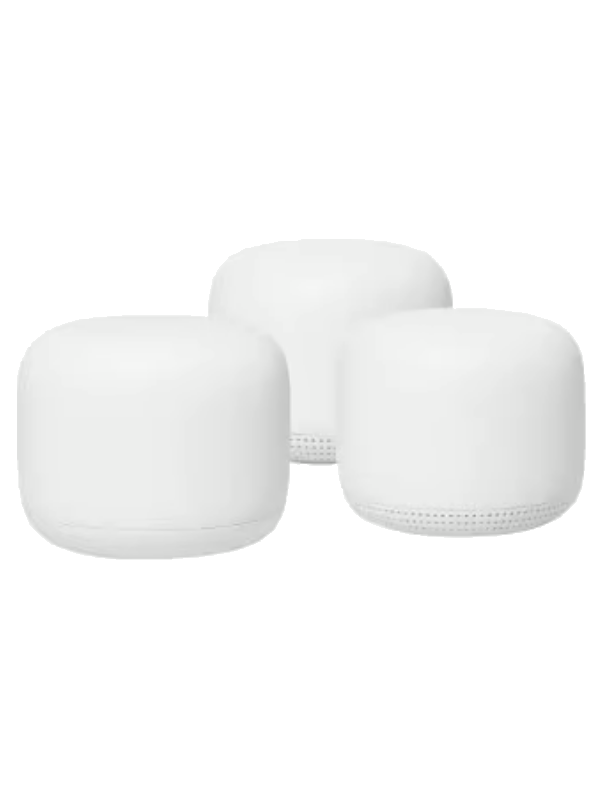
- Type: Wi-Fi Mesh router
- Tested max speed: 87.76Mbps
- Recommended for: 100 Mbps or below (and again, for those with big homes)
- Works with: 20-25 smart devices
- Wireless standard: Wi-Fi 6
- Warranty: 2 years
Pros
- Affordable
- Looks great
- Great features with Home integration
Cons
- Poor performance
The only people who will prefer Google Nest Wi-Fi over the Deco S4 are those planning on buying (or already owning) Google Home devices to set up an Internet of Things (IoT) household who also have an internet speed of less than 100 Mbps.
They’ll also need a large home or workplace to justify buying Mesh as is the case with any Mesh network.
Google Nest Wi-Fi integrates really nicely with the likes of smart lights, Nest thermostats and more all through the Home app. And that’s the best thing about it. It also doubles up as a smart speaker which we’re fans of. The whole system feels really neat.
But it comes at a cost: performance. Because there’s no Wi-Fi 6 and because the Wi-Fi is quite poor, it only managed a max download speed of 87.76 Mbps.
The range is okay for a Mesh network. For the original router, it’s 80ft. And for each additional satellite, it’s 50ft. So, similar to the S4. That being said, the max amount of devices you can connect to Nest Wi-Fi is five, leaving a theoretical range of 280ft.
In terms of other features, there’s not a lot going on. The security isn’t amazing, but on the up side, you do get two years worth of warranty which is always a nice thing to have, of course.
Nest Wi-Fi is still quite affordable, so it still counts as budget in our eyes. But it does cost more than the Deco S4. So if it’s Mesh your heart is set on, you’ll need to weigh up whether you want the IoT setup of Nest or the performance and price of Deco.
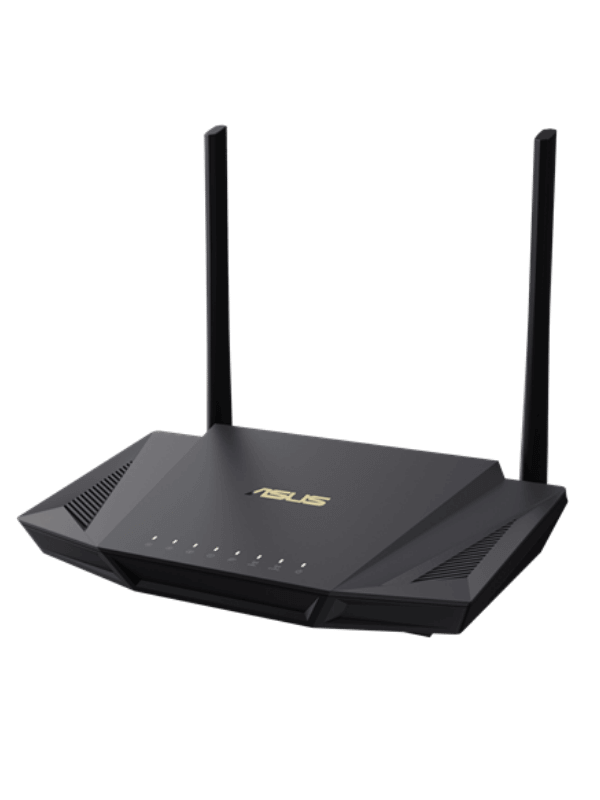
- Type: Wi-Fi router
- Tested max speed: 754.02 Mbps
- Recommended for: 700 Mbps or below
- Works with: 20-25 smart devices
- Wireless standard: Wi-Fi 6
- Warranty: 2 years
Pros
- Great value
- Surprisingly quick speeds
- Good features
Cons
- Poor range
If you’re a hardcore gamer who needs low mega low latency and superfast Wi-Fi, look no further than the ASUS RT-AX56U. It’s definitely at the upper-end of being a budget router price-wise but we still feel that it qualifies.
Our download speed test found that the RT-AX56U was capable of a huge 754.02 Mbps, making it acceptable for anyone with an internet plan of 700 Mbps or less.
Interestingly, the RT-AX56U doesn’t have the best range in the world. We didn’t manage to get a signal past the 75-80ft mark. However, it does have ASUS’s AiMesh feature, meaning you can connect it to a Mesh network.
But why is it so good for gaming? Because you can achieve low latency with ASUS’s awesome QoS. There’s even a particular gaming mode which will focus most of your router’s performance onto your games console of choice.
The extra features of this router are good, too. You’ll still get the likes of parental controls, a great app for controlling everything, MU-MIMO, OFDMA, beamforming and excellent security with ASUS’s AiProtection Pro.
That’s not the only protection you get here, either. ASUS gives you a decent two-year warranty as standard.
This is certainly a high-quality all-rounder router. Loads of features and super high performance combine to make it very desirable indeed. However, it’s one of the most expensive in the ‘budget’ category, if you can call it that.
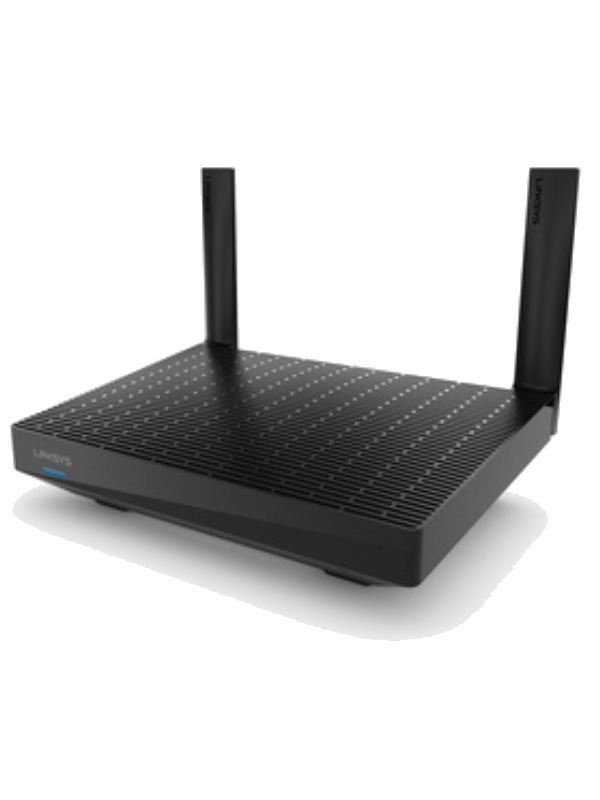
- Type: Wi-Fi router
- Tested max speed: 733.11 Mbps
- Recommended for: 700 Mbps or below
- Works with: 20-25 smart devices
- Wireless standard: Wi-Fi 6
- Warranty: 1 year
Pros
- Pretty fast
- Good range
- Affordable
Cons
- Poor features
- Needs to pay for antivirus
Those with a large home and an internet speed of 700 Mbps or less should also consider the Linksys Max Stream MR7350. A surprisingly high quality router from the Linksys team.
If you want to keep things really on a budget (e.g. without splashing out on a full-blown Mesh system), Linksys Max Stream series might be something to consider. It uses similar technology to allow for uninterrupted roaming for a pretty good price.
You’re going to get some serious coverage from this device. Despite being low on price (especially for a Linksys router), it performed very well in our tests. The top speed we managed to get from it was a cool 733.11 Mbps. On top of that, the original range of the router is good.
There are some extra features as well. These include Alexa compatibility, parental controls, and more. Although, you will have to pay if you want antivirus.
One downside here is that this is the only router from our picks that does not have a two year warranty as standard in the US. It carries the bare minimum of one year which is not going to be enough for some people.
It also suffers from pretty poor controls from a very average app including mediocre QoS. If you like to stay in control of your router, this might not be the one for you.
Overall, the Linksys Max Stream MR3750 offers an affordable way to get extended range albeit with a few issues.
Budget Router Buying Guide
Here’s a look at a few things to consider as you go about finding yourself a new budget router. For a more general guide, check out our router buying guide.
Wi-Fi 5 vs Wi-Fi 6
Wi-Fi 6 is better if you have more than 10+ smart devices or an internet connection over 500 Mbps. However, you can get away with Wi-Fi 5 for anything less.
Wi-Fi 5, released in 2014, was the highest performing Wi-Fi standard before the release of Wi-Fi 6 in 2019. This new version has the potential to be a lot quicker.
In fact, Wi-Fi 6 could be up to 250% faster than Wi-Fi 5. If you have a fast internet plan, this could be something to make the most of.
It’s worth noting that a lot of devices aren’t capable of handling Wi-Fi 6 yet. For example, any iPhone prior to iPhone 11 isn’t. So if you don’t have any Wi-Fi 6 devices, there’s not much point in having a Wi-Fi 6 router.
If you’re looking to keep your budget as low as possible, Wi-Fi 5 will be the better option for you because it’s cheaper. But of course, you’ll be limited on performance. But not necessarily as badly as it might seem.
The Deco S4 is a good example of Wi-Fi 5 performing well despite being Wi-Fi 5 only. Google Nest Wi-Fi, on the other hand, does not do such a great job with Wi-Fi 5.
On the flip side of all of that, you can still get Wi-Fi 6 routers for a low price. A great example is the TP-Link Archer AX10.
For more information, check out our article on Wi-Fi 5 vs. Wi-Fi 6.
Is Wi-Fi 6E affordable in budget and worth it?
Wi-Fi 6e features a 6 GHz band that’s more powerful than the 5 GHz band but has a shorter range.
If you’re most interested in the ‘best performer’ category of this article then you might want to look at Wi-Fi 6e. Then again, you probably won’t find a router that supports it within budget.
It could be worth it, but only if you have a Gigabit internet plan and plenty of smart devices that support it. Unfortunately, it’s a bit of a moot point as no budget routers support it yet.
If you want to learn more about Wi-Fi 6, click here.
What about Tri-band routers?
Tri-band routers offer an extra band to the standard 2.4 GHz and 5 GHz. This can either be the 6 GHz we mentioned just now, or a second 5 GHz band.
This is really useful for homes with lots of smart devices as it eases network congestion and lowers the risk of connections being dropped from individual devices. It will therefore improve the performance of the network as a whole.
If it’s 6 GHz, your device will need to be able to support this extra band. And not a lot of them can right now. Some devices are even unable to support 5 GHz.
Further to that, it’s not going to be possible to get a tri-band router in the budget category and probably won’t be for a few years yet. So, you’ll need to stick with dual-band if you’re on a budget.
For more information, check out our article on dual-band vs. tri-band routers.
Warranty
Does a longer warranty make a router more expensive? In our experience, the answer is no. An example of this is the Linksys Max Stream MR7350.
It’s no more affordable than any of the other routers in our list but it’s the only one with a warranty of one year compared to all the others, which provide two.
Can Mesh be on budget?
Absolutely! Earlier on, we mentioned a ‘best for Mesh’ category where we named the TP-Link Deco S4 the king for those on a budget. But that’s not even the only Mesh system in our list.
We also discussed Google Nest Wi-Fi but this one is more expensive. However, it offers cool integration with IoT if that’s what you’re into.
But what exactly is Mesh? It’s a technology that allows you to extend your home network range with additional satellites but no requirement to reconnect. This allows you to have a solid Wi-Fi connection over a much larger area then a traditional router.
This beats a standard Wi-Fi extender because these often require a separate network name, and you’ll need to reconnect when you go out of range of the original router.
A few years back, finding a Mesh system on a budget would have been impossible. But now it is thanks to the likes of the TP-Link Deco S4 and Google Nest Wi-Fi.
That being said, Mesh is still more expensive than no Mesh so if you want to keep costs super low, a traditional Wi-Fi extender is the route to go down.
Read Mesh Wi-Fi vs. traditional routers for more information.
Extra features
The more features a router has, the more expensive it tends to be. But that doesn’t mean a router with great features is out of the budget category by default. There are plenty of budget routers with awesome features.
Draw your attention to Google Nest Wi-Fi. It works beautifully with Google Home! And what about the ASUS RT-AX56U? This has some of the finest QoS going. But what exactly is it?
Quality of Service, or QoS for short, is a technology that allows you to direct more power from your network to specific devices. So if you’re about to go into a gaming session or want to download something as fast as possible, you can restrict other devices on the network to allow your priority device to thrive.
Another great extra feature that we recommend for anyone sharing their network with vulnerable internet users is parental controls. With this, you can restrict access to adult or harmful content to specific users. This can either be full-time or scheduled with some parental control apps. Most routers contain parental controls these days.
There are also extra Wi-Fi technologies like OFDMA, beamforming and MU-MIMO to look at. And these can really improve the performance of the router.
OFDMA and MU-MIMO go hand-in-hand as they improve a router’s ability to connect to multiple devices and improve speed, using slightly different technologies.
Beamforming is a little different as it combines each antenna’s beams to actively seek out connected devices. This results in less wasted signal and better overall speed.
You don’t necessarily have to pay a fortune for all these features but feature-heavy routers do tend to cost more.
Best Budget Routers FAQ
People have been asking a few questions about budget routers. Here are the most common ones and the answers to them.
What’s the fastest speed I can get with a budget router?
Just because a router is in the budget category, it doesn’t mean it’s a slow performer. It’s a common misconception! Our ‘best performer’ for today, the TP-Link Archer AX50, clocked in at a whopping 690.52 Mbps when we tested it.
Is it worth upgrading from the router my ISP sent me?
Your ISP will always send you a modem/router combo to get you online in the first place. But often, this will offer the bare minimum in the way of range, download speed for your plan, and extra features. Often, it’s worth upgrading even if you are on a budget.
Do I need any extra hardware to get online?
If you want to connect to a cable network, you’ll need two parts: a router and a modem. A lot of people tend to miss this. If you buy any of the routers in our list today, you’ll need to grab a modem as well.
Last Thoughts on the Best Budget Routers
Overall, we feel that the best budget router going right now is the TP-Link Archer AX10. It offers unbeatable value for money, and most people will be very happy with this router.
However, we also recommend considering the other six routers we’ve looked at today. One of those may just be better suited to your personal needs. Good luck on your search, and enjoy your new router!















![Toni Kroos là ai? [ sự thật về tiểu sử đầy đủ Toni Kroos ]](https://evbn.org/wp-content/uploads/New-Project-6635-1671934592.jpg)


